By Prof. Dr Sunil Muddaiah
Abstract
Orthodontic treatment of cleft lip and palate patients usually associated with a constricted maxilla is considered to be very challenging. RME is contraindicated in such cases because of absence of mid palatal suture. Slow maxillary expansion procedures produce less tissue resistance around the circum-maxillary structures and therefore improve bone formation in the intermaxillary suture. Through this case report, we will be presenting a case of maxillary expansion using a tandom looped , temperature activated nickel-titanium expander 2 of size 40mm by making use of its ability to produce light, continuous pressure on the mid palatal suture. After 4 months, the maxillary arch was expanded to the desired width.
Introduction
One of the most common congenital anomalies affecting the craniofacial region is cleft lip and palate. An interdisciplinary approach is required for a successful cleft lip and palate rehabilitation. Surgical closure of lip restricts the normal growth across the anterior part of the maxillary arch, and closure of cleft palate causes some degree of lateral constriction. So , surgically treated cleft palate patients develop both anterior and lateral crossbite. Transverse discrepancies in such cases can be corrected by maxillary expansion. [1]
Dr. Wnadell V Arndt of USA , in 1993 developed a pre programmed, tendon looped, semifixed, nickel titanium palatal expander, which produces light continuous forces producing slow maxillary expansion. [2] The central component of the expander has a thermoelastic NiTi while the anterior extension is made up of stainless steel.As the transition temperature of NiTi is 94 degrees, below this temperature it becomes flexible and facilitates insertion. When it reaches the mouth temperature, it will regain its original shape and thus, it exerts a force on the palatal vault thereby expanding it. [3]
Case report
A 11 year old female patient reported to the Department of Orthodontics and Orthopaedics, Coorg Institute of Dental Sciences, Virajpet, Karnataka. Her parent’s chief complaint was irregularly placed upper front teeth region.
Diagnosis and aetiology
The patient has normal Gait and normal Posture with Aesthetic built, Ectomorphic body type, Mesocephalic head form, Mesoproscopic facial form. The facial profile was Convex with a Posterior Divergence Clinical FMA was average. (Fig. 1)
Patient’s parent reported a history of surgery of lip done when she was 5 months old and surgery of palate , done 9 years back.
Intraoral examination shows mutilated malocclusion with constricted maxillary arch, upper and lower anterior crowding, with palatally placed 12, crossbite in relation to 21,22,and 63. All teeth from the permanent first molars have erupted in both the upper and lower arches, except 13,23, with retained 53,63 and 85. Dental caries in upper left and lower right molars were seen. Patient exhibited an overjet of 0mm and overbite of 2mm.( Fig. 2)
The amount of incisor exposure at rest was 0mm of upper incisor and during speech the amount of incisor exposure was found to be 2mm.Incisor exposure was during smile which was 4 mm of upper incisor.

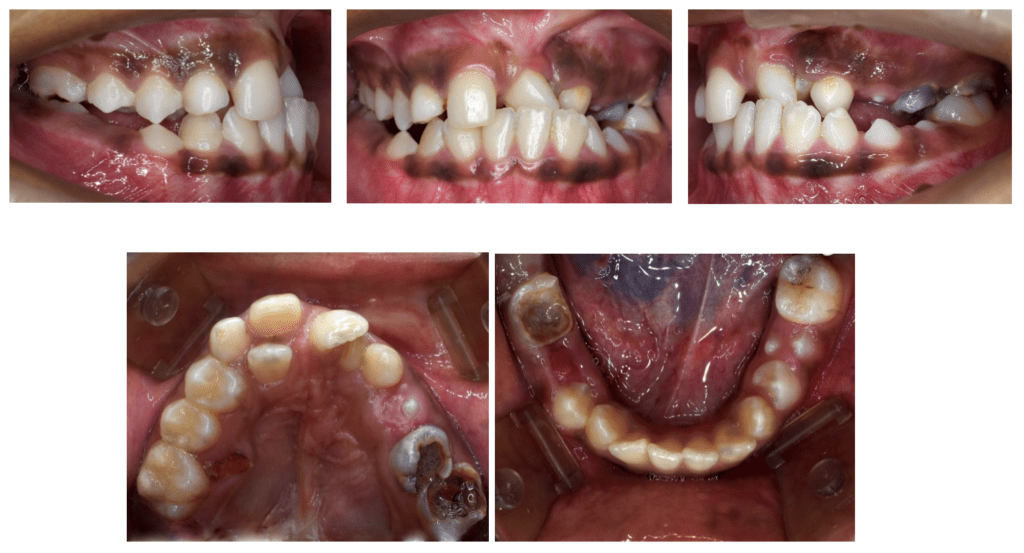
TMJ evaluation revealed No Clicking, No Pain on Mandibular Movements. Retrusive Upper lip and Lower Lip and acute nasolabial angle and obtuse mentolabial sulcus.
The CVMI and MP3 stages showed 85% of growth is remaining in this patient. The OPG confirmed the presence of all permanent teeth except 18 and 28 including the developing lower right and left third molar. Root morphology appeared normal. (Fig 3 & 4)



Treatment plan
For the correction of constricted maxillary arch , expansion was planned to correct the crossbite. Considering the patient compliance, NiTi palatal expander 2 (Fig. 6) of size 40 was used, as the width between the lower molar central fossa was measured to be 37mm.
After desired expansion of maxillary arch, secondary bone graft and fixed orthodontic therapy to be followed.
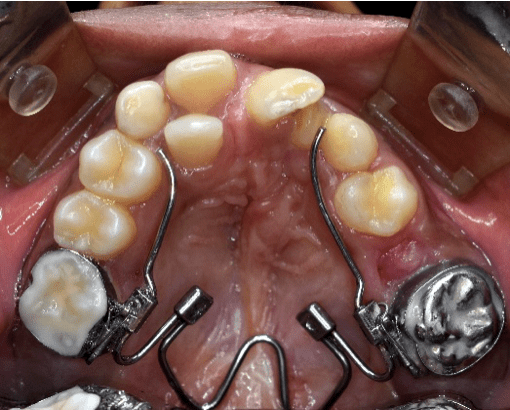
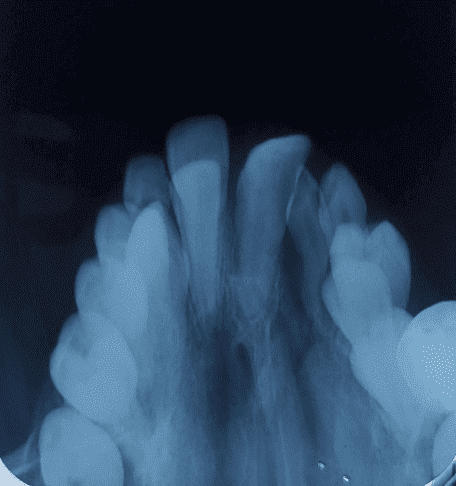
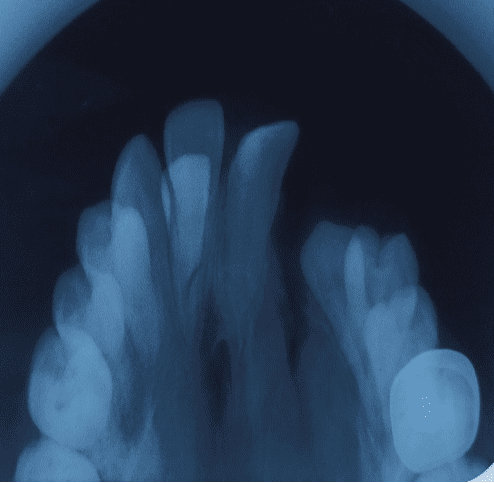
Treatment rationale
The nickel titanium component has a transition temperature of 94°F. At room temperature, the expander is too stiff for insertion. Below this temperature the expander softens the central component, allowing its easy manipulation. Once placed in the oral cavity, the expander warms to body temperature, stiffens, and begins to return to its original shape.A 3mm increment of expansion exerts only about 350g of force, and the nickel titanium alloy provides relatively uniform force levels as the expander deactivates.[2]
The expander is available in sizes from 26mm to 44mm. The mandibular intermolar width at the central fossae is measured to which 1-2 mm is added to determine the size of the expander to be selected.
Result
After 4 months, the arch was expanded to the desired width. Occlusal x-rays showed palatal separation during slow expansion procedure.(Fig. 7 and 8). Measurements were made in the dental casts according to the markings as shown in Figures 9 and 10.
<< Back to Contents Menu
EDITOR’S PAGE | ADVISORY BOARD | NEWS | PRODUCTS | COVER FEATURE | CLINICAL | PROFILE | EXHIBITIONS & CONFERENCES | DENTAL TECHNOLOGY | PRACTICE MANAGEMENT
The maxillary interpremolar width incresed from 32mm to 38mm and intermolar width increased from 43mm to 54mm after the expansion.(Table 1 Comparison of pre and post expansion of maxilla).
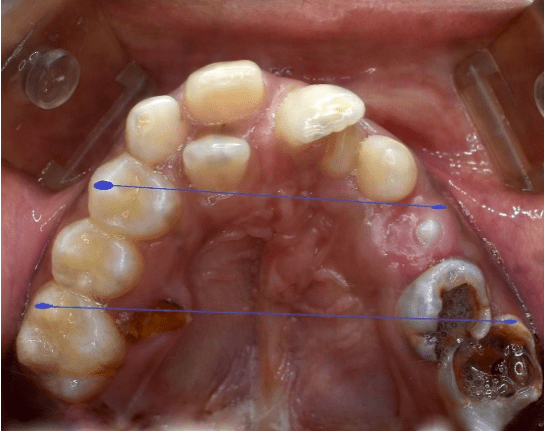

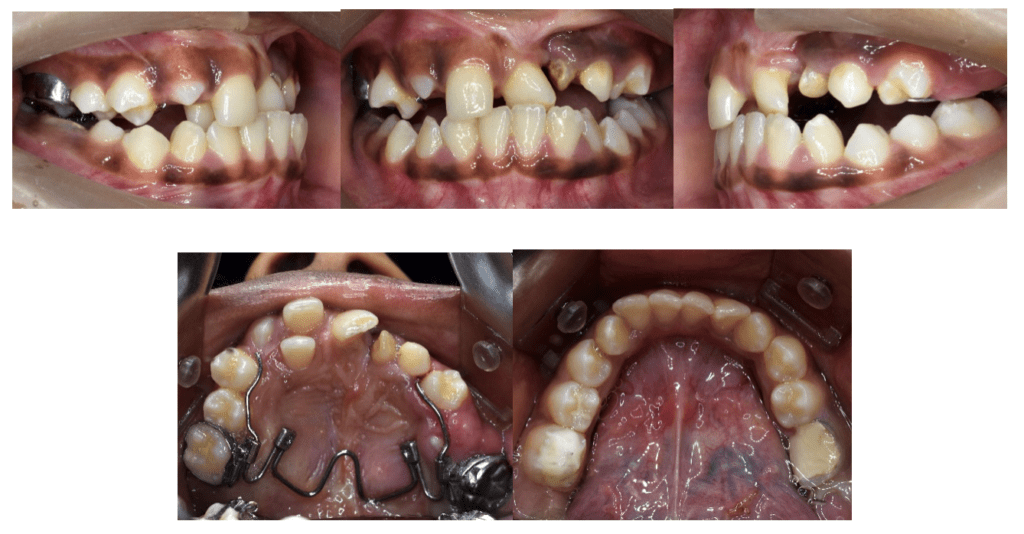
| Maxilla | Pretreatment | Postexpansion |
|---|---|---|
| Interpremolar width | 33mm | 43mm |
| Intermolar width | 47mm | 58mm |
Discussion
As the transition temperature of NiTi is 94 degrees, below this temperature it becomes flexible and facilitates insertion. When it reaches the mouth temperature, it will regain its original shape and thus, it exerts a force on the palatal vault thereby expanding it. [4]
According to Storey, slow expansion at a rate of 0.5-1mm per week helps in “physiological sutural adjustments”, because of less trauma and a greater repair response when compared to rapid expansion. Ekstrom says that mineralization occurs by three months. [5]
To compensate for the tendency of relapse to pretreatment measurements, overexpansion is done. [6]
Conclusion
NiTi palatal expander is an effective treatment approach for cleft lip and palate patients for the transverse expansion of the maxillary arch for the correction of crossbites.
Niti palatal expander is less bulkier when compared to conventional expanders and thereby helps in maintaining a good oral hygiene.
References
- Marzban R, Nanda R. Slow maxillary expansion with nickel titanium. Journal of Clinical Orthodontics. 1999 Aug 1;33:431-41.
- Arndt WV. Nickel titanium palatal expander. Journal of clinical orthodontics: JCO. 1993 Mar 1;27(3):129-37.
- Santoro M, Nicolay OF, Cangialosi TJ. Pseudoelasticity and thermoelasticity of nickel-titanium alloys: a clinically oriented review. Part I: Temperature transitional ranges. American Journal of Orthodontics and Dentofacial Orthopedics. 2001 Jun 1;119(6):587-93.
- Cotton LA. Slow maxillary expansion: skeletal versus dental response to low magnitude force in Macaca mulatta. American Journal of Orthodontics. 1978 Jan 1;73(1):1-23
- Storey E. Tissue response to the movement of bones. American journal of orthodontics. 1973 Sep 1;64(3):229- 47
- Nidhya Varshini Gurubaran, Thailavathy, Kannan Sabapathy, Balavenkata Barathi Chaturvedula. A NonCompliant Slow expansion devise in orthodontics: A case report on NiTi palatal expansion appliance. Clinical Dentistry 2021; XV; 23-27.
- Corbett, M.C.: Slow and continuous maxillary expansion, molar rotation, and molar distalization, J. Clin. Orthod. 31:253- 263, 1997
- Majourau, A. and Nanda, R.: Biomechanical basis of vertical dimension control during rapid palatal expansion therapy, Am. J. Orthod. 106:322-328, 1994
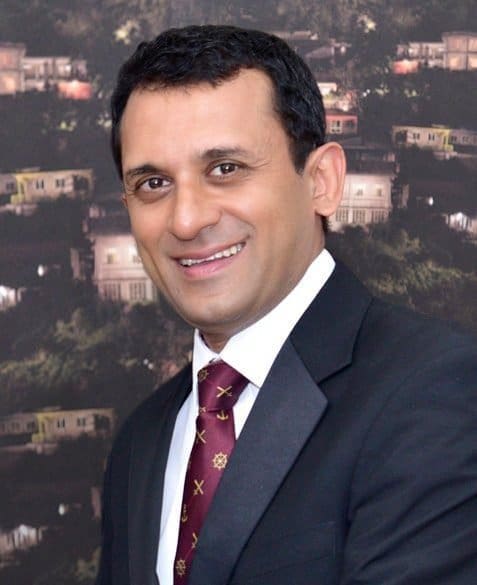
Prof. Dr Sunil Muddaiah is an accomplished professional in dentistry, specialising in orthodontics and dentofacial orthopaedics. He holds a Bachelor of Dental Surgery and a Masters in Orthodontics and Dentofacial Orthopaedics from Mangalore University, India.
Dr Muddaiah is the Professor and Chair at the Department of Orthodontics and Dentofacial Orthopaedics at the Coorg Institute of Dental Sciences, which he founded in 1999.
He founded Anuraadh, an NGO focused on supporting vulnerable communities in education and health. He also established Samaadhaan, a private clinical facility specialising in aesthetics, cosmetology, and specialised dental care.
Dr Muddaiah’s passion for research and innovation is evident through his initiatives. He founded the Aavishkaar Research Laboratory, conducting cutting-edge medical research. Furthermore, he is the founder and president of the International Dental Educationists’ Association (IDEA), promoting excellence in dental education worldwide.
Dr Muddaiah holds prestigious positions and memberships in professional organisations. He serves as the India Country Representative at the South-East Asia Association for Dental Education (SEAADE), the Country Representative for India at the Association of Dental Education of the Asia Pacific (ADEAP), and represents India at the International Dental Collaboration of the Mekong River Region (IDCMR).
The information and viewpoints presented in the above news piece or article do not necessarily reflect the official stance or policy of Dental Resource Asia or the DRA Journal. While we strive to ensure the accuracy of our content, Dental Resource Asia (DRA) or DRA Journal cannot guarantee the constant correctness, comprehensiveness, or timeliness of all the information contained within this website or journal.
Please be aware that all product details, product specifications, and data on this website or journal may be modified without prior notice in order to enhance reliability, functionality, design, or for other reasons.
The content contributed by our bloggers or authors represents their personal opinions and is not intended to defame or discredit any religion, ethnic group, club, organisation, company, individual, or any entity or individual.

